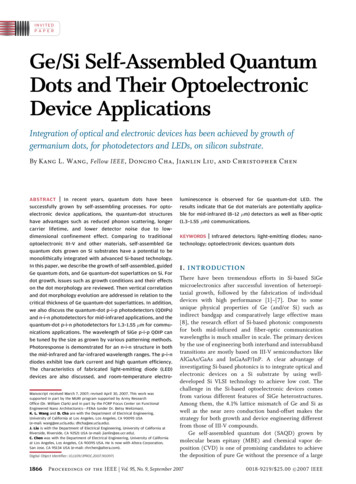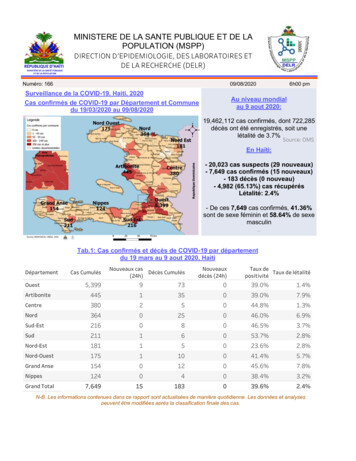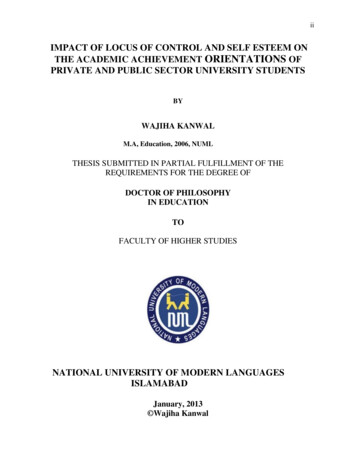
Transcription
INVITEDPAPERGe/Si Self-Assembled QuantumDots and Their OptoelectronicDevice ApplicationsIntegration of optical and electronic devices has been achieved by growth ofgermanium dots, for photodetectors and LEDs, on silicon substrate.By Kang L. Wang, Fellow IEEE , Dongho Cha, Jianlin Liu, and Christopher ChenABSTRACT In recent years, quantum dots have beenluminescence is observed for Ge quantum-dot LED. Thesuccessfully grown by self-assembling processes. For opto-results indicate that Ge dot materials are potentially applica-electronic device applications, the quantum-dot structuresble for mid-infrared (8–12 m) detectors as well as fiber-optichave advantages such as reduced phonon scattering, longer(1.3–1.55 m) communications.carrier lifetime, and lower detector noise due to low- Infrared detectors; light-emitting diodes; nano-dimensional confinement effect. Comparing to traditionalKEYWORDSoptoelectronic III-V and other materials, self-assembled Gequantum dots grown on Si substrates have a potential to betechnology; optoelectronic devices; quantum dotsmonolithically integrated with advanced Si-based technology.In this paper, we describe the growth of self-assembled, guidedGe quantum dots, and Ge quantum-dot superlattices on Si. Fordot growth, issues such as growth conditions and their effectson the dot morphology are reviewed. Then vertical correlationand dot morphology evolution are addressed in relation to thecritical thickness of Ge quantum-dot superlattices. In addition,we also discuss the quantum-dot p-i-p photodetectors (QDIPs)and n-i-n photodetectors for mid-infrared applications, and thequantum-dot p-i-n photodetectors for 1.3–1.55 m for communications applications. The wavelength of SiGe p-i-p QDIP canbe tuned by the size as grown by various patterning methods.Photoresponse is demonstrated for an n-i-n structure in boththe mid-infrared and far-infrared wavelength ranges. The p-i-ndiodes exhibit low dark current and high quantum efficiency.The characteristics of fabricated light-emitting diode (LED)devices are also discussed, and room-temperature electro-Manuscript received March 7, 2007; revised April 30, 2007. This work wassupported in part by the MURI program supported by Army ResearchOffice (Dr. William Clark) and in part by the FCRP Focus Center on FunctionalEngineered Nano ArchitectonicsVFENA (under Dr. Betsy Weitzman).K. L. Wang and D. Cha are with the Department of Electrical Engineering,University of California at Los Angeles, Los Angeles, CA 90095 USA(e-mail: wang@ee.ucla.edu; dhcha@ee.ucla.edu).J. Liu is with the Department of Electrical Engineering, University of California atRiverside, Riverside, CA 92521 USA (e-mail: jianlin@ee.ucr.edu).C. Chen was with the Department of Electrical Engineering, University of Californiaat Los Angeles, Los Angeles, CA 90095 USA. He is now with Altera Corporation,San Jose, CA 95134 USA (e-mail: chrchen@altera.com).Digital Object Identifier: 10.1109/JPROC.2007.9009711866I . INTRODUCTIONThere have been tremendous efforts in Si-based SiGemicroelectronics after successful invention of heteroepitaxial growth, followed by the fabrication of individualdevices with high performance [1]–[7]. Due to someunique physical properties of Ge (and/or Si) such asindirect bandgap and comparatively large effective mass[8], the research effort of Si-based photonic componentsfor both mid-infrared and fiber-optic communicationwavelengths is much smaller in scale. The primary devicesby the use of engineering both interband and intersubbandtransitions are mostly based on III-V semiconductors likeAlGaAs/GaAs and InGaAsP/InP. A clear advantage ofinvestigating Si-based photonics is to integrate optical andelectronic devices on a Si substrate by using welldeveloped Si VLSI technology to achieve low cost. Thechallenge in the Si-based optoelectronic devices comesfrom various different features of SiGe heterostructures.Among them, the 4.1% lattice mismatch of Ge and Si aswell as the near zero conduction band-offset makes thestrategy for both growth and device engineering differentfrom those of III-V compounds.Ge self-assembled quantum dot (SAQD) grown bymolecular beam epitaxy (MBE) and chemical vapor deposition (CVD) is one of promising candidates to achievethe deposition of pure Ge without the presence of a largeProceedings of the IEEE Vol. 95, No. 9, September 20070018-9219/ 25.00 Ó 2007 IEEE
Wang et al.: Ge/Si Self-Assembled Quantum Dots and Their Optoelectronic Device Applicationsdensity of dislocations, leading to lower leakage current.Multilayer Ge dots interlaced with thin Si layers can thenbe grown for increasing the quantum efficiency. Theability of self-assembled Ge quantum dots by the Stranski–Krastanov (SK) method to form the energy-quantizedislands without any artificial masking and patterning aswell as their compatibility with the current Si technologyprovides potentials for the fabrication of novel devices onSi [9]–[11]. On the other hand, the long-standing issues ofGe SAQD on Si, such as size control and exact placementof dots, have been the problems. More recently, theseproblems are resolved by guided growth, usually selectiveepitaxial growth on patterned mesas or patterned holeswith nanometer-scale width, depth, and period [12]–[16].By the use of these patterning-assisted quantum dots(PAQDs) with uniform size and placement, high densityhas been achieved on Si.Ge/Si quantum dots exhibit a type-II band lineup[17]. The large valence band offset leads to an effectiveconfinement of holes in the Ge region while electronsare mostly presented in the Si layers. In case ofinterband transition, one has to change the dot size orGe mole fraction in dots to tune the photoresponse tothe desirable spectral region, like around 1.55 m. TheGe/Si SAQD system may also have potential applicationsfor fabricating on-chip light-emitting sources. Therewere some theoretical results on an indirect-to-directconversion of the optical transition of SiGe quantumdots due to small enough size of the quantum dots [18],[19]. Photoluminescence studies have been carried outextensively on the Ge/Si quantum dots [20]–[25], andthe electroluminescence of Ge quantum dots wasobserved up to room temperature in the spectral regionaround 1.3–1.5 m [26].In this paper, we mainly deal with the fabrication of GeSAQDs, PAQDs, and multilayered quantum dots (MLQD)on Si (100), their optoelectronic properties, and relatedoptoelectronic devices. First, the growth of Ge quantumdots and the corresponding formation mechanism will bediscussed. Then, the results of near-infrared properties ofGe quantum dots by photoluminescence studies will bedescribed, followed by the description of mid-infraredproperties of boron-doped Ge quantum dot and phosphorus -doped Ge quantum dot. Finally, optoelectronicdevices based on Ge quantum dots are reported.to 3-D island growth. A lattice constant mismatch betweenthe Si and Ge atoms is a key driving force for the dotformation. At the beginning of the growth of Ge on Si,misfit strain is built up and fully accommodated. Once theGe film thickness exceeds its critical thickness of a fewmonolayers, the strain starts to relax, small pyramidalislands are formed, and the film morphology becomesrough. Those small islands may evolve to large domes aftermore Ge is deposited. When Ge deposition exceeds 2 nm,misfit dislocations and threading dislocations form torelieve the additional strain arising from the accumulationof the film thickness [28]. This strain-related selfassembled dot formation offers the possibility to fabricateislands with uniform size without any substrate patterningprocess.Fig. 1 shows a 2-D AFM image of Ge SAQDs on Si (100)substrate. Ge dots were grown at 550 C by MBE [29]. Thegrowth method employed in this study is MBE unlessspecified otherwise. The nominal Ge thickness is 1.7 nm.Two kinds of Ge dots are shown. The larger dots aremultifaceted domes (A) and the smaller dots are squarebased pyramids (B). They have a distinct shape and adistinguishable size distribution. They are referred to as abi-modal distribution [30]. A bi-modal distribution of Gedots is a typical experimental result for Ge/Si (100).Based on kinetic and thermodynamic analyses, thereare two basic interpretations for the experimental observations. In real-time low-energy electron microscopy,Ross et al. [31] studied the evolution of Ge SAQDs andII . SELF-ASSEMBLED AND GUIDED GeQUANTUM DOTSIn heteroepitaxial growth, there are generally three growthmodes: namely, the Frank van der Merwe (FM), theVolmer–Weber (VW) and the SK growth modes [27]. Theycan be described as layer-by-layer growth, island growth,and layer-plus-island growth, respectively. Ge films grownon Si follow the SK growth mode. The dot formation viathe SK mode uses the transition from the 2-D layer growthFig. 1. 2-D AFM image of typical bi-modal Ge dots: (A) multifaceteddomes and (B) square-based pyramids [29].Vol. 95, No. 9, September 2007 Proceedings of the IEEE1867
Wang et al.: Ge/Si Self-Assembled Quantum Dots and Their Optoelectronic Device Applicationsfound that the size of large dots increased at the expenseof small dots and concluded that it was a kinetic processdriven by an Ostwald ripening effect. Based onthermodynamic analysis, Shchukin et al. [32] proposedthat for some systems, there are minima in the freeenergy of self-assembled dot ensembles showing the sizewith a stable Boltzmann distribution. Kamins et al. [33]conducted annealing experiments to distinguish thestages of the two mechanisms, Ostwald ripening andequilibrium distribution. They found that dot evolutionwas slowed with increasing annealing time at 550 Cand 600 C. It would finally reach an equilibriumdistribution.For many potential applications, the control of the dotsize distribution is one essential issue. A narrow distribution or high uniformity is desirable. A bi-modal or multimodal distributions of dots in Ge/Si (100) system areobstacles for accomplishing a uniform size of dots. Theuniformity of dots has been found to depend critically onthe growth parameters, such as growth temperature,growth rates, Ge deposited coverage, and holding time atthe growth temperature after Ge deposition. Uniformmono-modal quantum dots can be obtained by properlycontrolling these growth conditions. The study of thegrowth temperature influence on the formation of theself-assembled Ge dots on Si (001) substrates wasreported. For the Ge growth rate of 0.2 Å/s and the Gecoverage of 1.5 nm, the growth temperature for achievinga high uniformity in the dot size was found to be around600 C. Fig. 2(a) shows a 2-D AFM image of the highlyuniform Ge dots on Si (100) substrate at a growthtemperature of 600 C [34]. Fig. 2(b) is the composed 3-Dview. The dots are all dome-shaped with the base size andthe height of about 70 nm and 15 nm, respectively. Theareal density of the dots is about 3 109 cm 2 and theheight deviation of the dots is about 3%. This resultdemonstrates the possibility of uniform Ge dots on SiFig. 2. (a) 2-D AFM image of the uniform self-organized Ge dotson Si (0 0 1) at the growth temperature of 600 C. The Ge thicknessis about 1.5 nm. The base size and the height of the dots are about70 nm and 15 nm, respectively, and the height uniformity of the dotsis about 3%. The areal density of the dots is about 3 109 cm 2 .(b) The corresponding 3-D AFM image [34].1868Fig. 3. The number ratio of pyramids to domes versus growthtemperature. The optimum temperature is about 600 C forthe formation of mono-modal morphology dots. Note that theat high temperature, small dots occur in the precursor state arenot counted [29].(100). The possible mechanism associated with the highlyuniform distribution was attributed to the enhanceddiffusion [35].Fig. 3 plots the number ratio of the pyramids to thedomes versus the growth temperature as reported in [29].It is interesting to find a nearly symmetric behavior withthe center temperature at 600 C. As the temperatureincreases from 500 C, the ratio of the bi-modal dotsreduces and reaches a minimal value at about 600 C, andthen increases again beyond this temperature. The optimum growth temperature for the formation of the monomodal distribution of the Ge dots occurs at 600 C. Theformation of the mono-modal distribution was attributed tothe enhanced diffusion kinetics at higher growth temperatures. The dot size increases as the temperature increases,leading to the accommodation of larger strain in the dots,especially around the dot edges. On the other hand, theintermixing may occur and becomes pronounced as thetemperature increases beyond 650 C [36], which resultsin the modification of the interface strain distribution, andthus leads to the reoccurrence of bi-modal dots. Due to theintermixing of Si with Ge, the wetting layer is no longer apure Ge layer, but a SiGe-like layer, and then the latticemismatch becomes smaller than 4.1%, and the strainenergy is thus reduced leading to the larger pyramids athigher temperatures [37]. Meanwhile, the relaxation of thestrain around the edges will cause dislocations to develop,which increase the intermixing by lowering the intermixing barrier. However, at lower temperatures ð 550 CÞ,the diffusion is limited and impedes the formation ofuniform dots.In order to clarify the dependence of dot density ontemperature, the values of the average dot spacing (alsoProceedings of the IEEE Vol. 95, No. 9, September 2007
Wang et al.: Ge/Si Self-Assembled Quantum Dots and Their Optoelectronic Device Applicationscalled the characteristic length) Lc , which was defined asthe inverse of the square root of the areal density , werecalculated from the experimental results. Fig. 4 plots theArrhenius relation of the average dot spacing Lc versusgrowth temperature [29]. It is found that a discontinuityof Lc occurs at the temperature of 600 C with twoslightly different slopes, corresponding to the activationenergies of 0.88 eV and 0.91 eV, respectively. Thesesuggest that diffusion is not the only driving force fordetermining the dot density at higher temperatures.Intermixing of Si with Ge taking place at the temperatureof above 600 C [38], [39] may also be responsible for theobserved discontinuity. The change of activation energyalso indicates the change of the mechanism from enhanced diffusion at lower temperatures to the intermixingof Si with Ge at higher temperatures investigated.For electronic and signal processing applications,controlled spatial arrangement is usually required. Inorder to control spatial distribution, much effort has beendevoted using a variety of techniques, such as growth onmiscut substrates with surface steps [40] and on relaxedtemplates with dislocation networks [41], [42] andstacking growth of multilayers of dots [43], [44]. One ofthe most effective approaches is using selective epitaxialgrowth (SEG) mesas as templates for subsequent Gegrowth [34]. Fig. 5(a) shows a 3-D AFM image of selforganized Ge dots on the h110i oriented Si stripe mesas,formed on the exposed Si stripe windows with a windowwidth of 0.6 m and a separation between two stripes of0.1 m. Perfectly aligned and regularly spaced 1-D arraysof the Ge dots are formed on the ridges of the Si stripeFig. 4. The characteristic length (Lc ) versus the temperature,where the square of the length (L2c ) is defined as inverse areal dotdensity. Note that the y-coordination is in a logarithmic scale toclarify the Arrhenius relation [29].Fig. 5. (a) A 3-D AFM image of the self-assembled Ge dots on theh110i oriented Si stripe mesas with a window width of 0.6 m.Self-aligned and well-spaced 1-D arrays of the Ge dots are formedon the ridges of the Si mesas after the deposition of 10 ML Ge.(b) The 2-D image of the dot arrays in (a). (c) The cross sectionsof the mesas (line AA0 ) and one array of the dots (line BB0 ),respectively [34].mesas. This almost perfect alignment of the dots alongthe Si stripe mesas is due to the formation of the ridges,which results from the full reduction of the top surface ofthe stripe mesas. Fig. 5(b) depicts the 2-D image of thedot arrays in Fig. 5(a). The cross-sectional profile of themesas and an array of the dots are shown in Fig. 5(c).The average sizes of the Ge dots are about 80 nm wideand 20 nm high, and the period is about 120 nm. Theregimented arrangement is the result of cooperativeinteraction from the neighboring dots caused by thebalance of diffusion, the strain energy, and the repulsiveinteraction among the dots. The repulsive interactioncomes from the elastic tensile deformation of the substrate by the dots [45], [46].The patterned substrates can be used for fabricatingquantum dots (PAQD) with uniform size and placement,and high density. One method to get these nanopatternedsubstrates as a template is to use a self-assembled diblockVol. 95, No. 9, September 2007 Proceedings of the IEEE1869
Wang et al.: Ge/Si Self-Assembled Quantum Dots and Their Optoelectronic Device Applicationscopolymer [47], [48]. Here, we show Ge quantum-dotgrowth in nanopatterns on Si (100) substrate by solidsource MBE [49]. Si substrates with hexagonally orderedhole patterns on the surface are prepared using a selfassembled diblock copolymer. Typical diblock copolymerused in our work is polystyrene-block-poly(methylmethacrylate) (PS-b-PMMA) [50], [51]. The process is describedin Fig. 6(a). A 30 nm layer of SiO2 is deposited on thewafer by low-pressure chemical vapor deposition(LPCVD). Then, a 30 nm layer of PS-b-PMMA is spincoated on top of the SiO2 . With an annealing at 170 C invacuum, PMMA become spatially separated from PS in ahexagonal close-packed configuration. After exposure toultraviolet (UV) for 35 min, the PS is cross-linked and thePMMA is separated. After rinsing in acetic acid, cylindrical pores are produced in the PS matrix. By a CHF3dry etch, the hexagonally organized cylindrical pattern ofPS-b-PMMA on the top layer is transferred to the underlying SiO2 layer forming hole patterns with a diameter of,e.g., 30 nm, a center-to-center distance of 40 nm, adepth of 20 nm, and a density of 1011 cm 2 . Thegrowth conditions are chosen to be selective in the patterned holes. The typical growth rates of Si and Ge are 0.4and 0.25 Å/s, respectively. To ensure desorption of GeOand SiO, the growth temperatures are kept at 620 C forSi and 530 C for Ge layers. Fig. 6(b) is a plan-view SEMimage of the Ge dots with the SiO2 mask etched away.The Ge dots are grown at 530 C with a 4 nm coverage.Fig. 6. (a) Ge PAQD growth on the nanopattern. (1) PMMA separated from PS in regularly spaced hexagonal-close-packed arrangement.(2) Removal of PMMA by ultraviolet radiation and rinsing in acetic acid. (3) Dry etch of oxide in CHF3 plasma. (4) MBE growth of Ge PAQDcapped by Si. The dots are selectively grown on Si substrate. (b) Plan-view SEM image of Ge PAQDs with the SiO2 mask etched away.Dots are grown at 530 C with a 4 nm coverage. It shows hexagonally ordered small Ge quantum dots with an average height of 5 nm,a lateral size of 30 nm, and a high density of 1011 cm 2 .1870Proceedings of the IEEE Vol. 95, No. 9, September 2007
Wang et al.: Ge/Si Self-Assembled Quantum Dots and Their Optoelectronic Device ApplicationsThe hole-patterns provide the preferential nucleation sitesfor the Ge dots. The Ge PAQDs have an average height of5 nm and a lateral size of 30 nm. It also shows a highdensity of 1011 cm 2 and a high ordering with hexagonal symmetry. These pattern qualities could not beeasily achieved using planar nonpatterned substrates.These results show that the use of the template growth isan important alternative approach to obtain dots fordevice applications, such as IR, diode, lasers, and singleelectron devices. The approach of using a self-assembleddiblock copolymer to achieve nanopatterns on Si substrates for ordered Ge quantum dots holds a high promise.II I. MULTILAY ERED Ge QUANTUM DOTS(Ge MLQD)For some applications such as optoelectronics, multilayered Ge quantum-dot superlattices are very important.An interesting feature observed in the multilayeredstructures is vertical correlation during deposition of Ge/Si multilayer structures. The origin of the vertical correlation may be attributed to preferential nucleation dueto an inhomogeneous strain field induced by buried dots[52]. The Si cap layers are tensilely strained above theFig. 7. Cross-sectional TEM images of (a) 10, (b) 20, (c) 35,and (d) 50-period Si (20 nm)/Ge (1.5 nm) superlattice samples.Vertically correlated dots are observed for all four samples,but the high-density of dislocations is evident for the50-period sample. The samples are grown at 540 C bythe SK growth mode.Fig. 8. AFM images of Si (20 nm)/Ge (1.5 nm) multilayershaving (a) 2, (b) 5, (c) 10, (d) 20, (e) 35, and (f) 50 periods.The increasing uniformity is clearly observed as the period increases(G 35 periods). The surface under the dot layer for the 50-periodsample exhibits clearly some circular holes with one of themdecorated by a circle, which are induced by threading dislocations.The dots near to these holes tend to nucleate near the edges.The samples are grown at 540 C by the SK growth mode.buried Ge dots, but the surface is usually not flat after theSi cap layer growth, even if the Si capping layer thicknessexceeds the island height. The surface roughness isstrongly correlated with the mechanism of the verticalalignment of Ge islands on Si for a multilayer structure. Inmany publications, the evolutions of the dot size, the sizedistribution, and the density of dots in the Ge dot multilayers have been observed [52], [53]. Here, we report themorphology of Ge dots and misfit dislocations as a function of the number of multilayers.Fig. 7 shows the cross-sectional TEM images ofsamples. The difference of the samples was the multilayerperiod. The samples were grown at 540 C by the SKgrowth mode having the Ge and Si nominal thicknesses of1.5 and 20 nm in each period, respectively. Coherentvertical-correlated Ge dots were observed for all foursamples. But, a high-density dislocation was generatedwhen the film reached the 25th period for the 50 periodsample. The dislocations penetrated to the subsequentlayers on top. Fig. 8 shows the AFM images of the topsurfaces of the Ge quantum-dot superlattice samples withdifferent periods of 2, 5, 10, 20, 35, and 50. For thesamples with fewer than 35 periods, the size uniformityof Ge quantum dots increases with an increasing numberof periods. The surface under the dot layer is relativelyflat. For the sample having 50 periods, the surface underthe dot layer shows some circular holes induced bythreading dislocations. Fig. 9 shows the Ge dot densityand the root-mean-square (rms) dot height relative to theaverage dot height (h Hi hHi indicates nonuniformity)as a function of the number of periods. The density ofdots decreases dramatically as the period increases andsaturates at 2 109 cm 2 when the period exceeds 20.Vol. 95, No. 9, September 2007 Proceedings of the IEEE1871
Wang et al.: Ge/Si Self-Assembled Quantum Dots and Their Optoelectronic Device Applicationsthe subsequent Ge dot layers, and calculated that the arealdensity of the subsequent Ge dot layer also varied with theSi spacing layer thickness.I V. INTERBAND ANDINTE RSUBBAND PROPERTIESFig. 9. Ge quantum-dot density and rms height relative to averageheight as a function of the period for Si (20 nm)/Ge (1.5 nm)multilayers. The dot density decreases dramatically as the periodincreases and saturates at about 2 109 cm 2 when the period reaches20. After 35 periods, the density increases slightly, indicating thechange of growth mode or the generation of threading dislocationsin the samples. The increasing uniformity with the multilayer periodfewer than 35 is observed. After the first 35 periods, the uniformitybecomes worse. The trend of the data for both the density and theheight of dots suggests the change of growth mode or the generationof threading dislocations in the thick samples.After 35 periods, the density increases slightly, indicatingthe change of growth mode or the generation of threadingdislocations in the samples. The increasing uniformitywith the multilayer period fewer than 35 is evident. Itcomes from the increasing uniformity of the straindistribution in the upper layers as predicted by the elasticcontinuum model [54]. For samples having greater than35 periods, the uniformity becomes worse, showing a veryhigh density of threading dislocations due to strainrelaxation.The strain-related vertical correlation is related tospacer layer thickness. The strain field from the underlying coherent dots can penetrate through the thin Sispacer layers. When the spacer layer becomes thicker thana critical value, the random arrangement of Ge dots isresulted. Therefore, the Si spacer layer thickness is thekey factor to keep vertical correlation and can influencethe distribution of the misfit strain on the surface.Rahmati et al. [55] found that the strain field from theburied islands was too weak to induce vertical correlation when the Si spacer layer thickness was greater than100 nm. Kienzle et al. [56] examined the vertical correlation of Ge dots as a function of Si spacer layer thickness. They found the increase of the average island sizewith increasing the number of layers. There seems to havea transition regime from the perfect correlation to randomarrangement as the thickness of the Si spacer layer increases from 30 to 100 nm. Tersoff et al. [54] examined theinfluence of the areal density of the initial Ge dot layer on1872For near-infrared optoelectronic applications, it is veryimportant to understand interband optical properties.Fig. 10 shows a low-temperature photoluminescence(PL) spectrum at 4.2 K of the Ge quantum-dot superlattice with a Ge dot height of 12 nm and a base diameter of 110 nm. This sample contains ten periods ofGe/Si (20 nm) layers. It was grown at the temperatureof 540 C. The peaks at 1.153, 1.132, 1.095, 1.061, and1.027 eV are presumably originated from Si and theycorrespond to nonphonon (NP) replica, transverseacoustic (TA), transverse optical (TO), 2TA þ TO, andTO þ O peaks, respectively. The broad peak with thepeak energy at 0.963 eV is attributed to the Ge wettinglayer. The peak at 0.771 eV is from the Ge quantumdots. The inset shows the possible mechanism for the NPpeak arising from the Ge quantum dots. The Ge/Si multilayer structure has a type-II band alignment. Radiativerecombination occurs between electrons in the Si layersand holes confined in the Ge dots, giving rise to the Gequantum-dot peak in the PL spectrum. To the first-orderestimation, the energy of the ground state mainly stemsfrom the vertical quantum confinement due to the heightof the dots. The lateral sizes of our dots are more than110 nm, a value that is too large to induce lateralconfinement.The PL spectra of three samples with different Gecoverages are shown in Fig. 11. Each sample contains tenperiods of Ge/Si (20 nm) layers. These samples were grownFig. 10. Typical low-temperature PL spectrum of a 10-period Gequantum-dot film at 4.2 K. The inset shows the mechanism of theemission of the quantum-dot peak at 0.771 eV.Proceedings of the IEEE Vol. 95, No. 9, September 2007
Wang et al.: Ge/Si Self-Assembled Quantum Dots and Their Optoelectronic Device Applicationsdecreases, leading to the blue shift of the quantum-dotpeak. The integrated PL intensity of the quantum-dot peakincreases as the number of periods increases to 35, thensuddenly decreases afterwards. In this case, due to thestrain relaxation, threading dislocations appeared todegrade PL.Intersubband transition in quantum confined semiconductor nanostructures is a subject of interest both forfundamental physics as well as for the development ofinfrared photodetectors and sources in the mid-infraredregion. Self-assembled quantum dots (SAQDs) based onthe SK growth mode are pancake-like dots with relativelylarge base dimensions of 50–100 nm, short heights of7–10 nm, and a low areal dot density of 109 1010 cm 2 .Such SAQDs have poor lateral confinement, and thus doesnot have normal-incidence absorption characteristics,similar to the quantum well case.We have demonstrated infrared absorption in GePAQDs grown on nanopatterned substrates. The processhas been described in the previous sections. In order toachieve infrared absorption between two valence band substrates, the dots are doped with boron to a concentrationFig. 11. PL spectra at 4.2 K for a series of samples with differentdot heights of 12, 14, and 16 nm. As the dot size increases,the quantum-dot NP peak shifts to the low-energy side.The energy shifts by about 28 meV for the dot height changingfrom 12 to 16 nm.on Si (100) substrates at 540 C. AFM measurementsindicate that the dot heights are 12, 14, and 16 nm, whilethe dot base diameters are 110, 122, and 122 nm, respectively. As the dot height increases from 12 to 16 nm, theNP peak of the quantum dots shifts by 28 meV to the lowenergy along with a decrease in the integrated peakintensity under each dot peak. The latter fact furthersupports the argument in favor of the type-II bandalignment for the Si/Ge dot system; the holes and electronsare separated in the Ge and Si in a type-II structure,respectively (shown in Fig. 10, inset). As the dot sizedecreases, the energy increases, and the hole wave functionpenetrates more into the Si layer; likewise, the electronwave also penetrates into the Ge dot. As a result, theoscillation strength becomes larger with the overlap ofthese wave functions.Fig. 12(a) shows the PL results for samples with thedifferent numbers of periods. Each period consists of Si(20 nm)/Ge (15 nm). Fig. 12(b) gives the quantitativesummary of the quantum-dot peak energy as a function ofthe number of periods. The effect of the period on thequantum-dot peak is obvious. As the period increases toabout ten, the peak en
Ge SAQD on Si, such as size control and exact placement of dots, have been the problems. More recently, these problems are resolved by guided growth, usually selective epitaxial growth on patterned mesas or patterned holes with nanometer-scale width, depth, and period [12]-[16]. By the use of these patterning-assisted quantum dots











